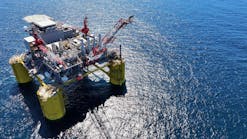W. CANADA PLAINS TRIASSIC-2 ECONOMIC GAS RESOURCES REMAIN IN WESTERN CANADA TRIASSIC PLAYS
S.M. Dallaire R.R. Waghmare L. Roux R.F. Conn
Natural Resources Canada
Ottawa
This article reviews the estimates of economic potential of the undiscovered natural gas resources estimated to exist in the Triassic System of the interior plains region of the Western Canada sedimentary basin.
This work was recently released as Part II ("Economic Analysis") of Geological Survey of Canada (GSC) Bulletin 4831. It is the second in a series of multidisciplinary studies reviewing the petroleum geology, discovered and undiscovered gas resources, and economic potential of natural gas in the Western Canada basin.
Economic potential measures the portion of the undiscovered resource which can be expected to provide economic investment opportunities over the long term, By taking costs and other economic constraints into account, a more realistic estimate of the resources of commercial interest to industry is provided. Estimates of economic potential are also relevant in supply/demand forecasting, in the resource management mandates of governments and regulatory bodies, and in the strategic planning of transportation systems.
TERMINOLOGY
The term potential refers to the undiscovered resource, or the portion of the resource base that is inferred to exist but is not yet discovered.
The term supply price is defined as the minimum plant-gate price of natural gas and co-products required to recover all costs associated with the exploration, development and production of gas resources found in a pool, including taxes, royalties and a minimum real discounted cash flow rate-of-return of 10%. Supply prices are measured for full-cycle and half-cycle cases. The full-cycle case includes all exploration, development and production costs, including taxes, royalties, and corporate overhead, but excludes land acquisition costs. The half-cycle case excludes all predevelopment costs.
Economic potential, at a given price, is the sum of resources having supply prices less than or equal to the given price. The supply price-economic potential relationship is defined as the supply curve, or marginal cost curve.
METHODOLOGY
The geological analysis and resource assessment are undertaken at the exploration play level.1 Existing discoveries in a play are used to estimate the number and individual sizes of undiscovered pools in the play.3 The undiscovered pools in a play are treated as a set of investment opportunities, and project economics is used to estimate the supply price for each pool. Economic potential is then estimated using these supply prices. Costs and supply prices are estimated in 1990 dollars. For a full description of the methodology and assumptions, the reader is referred to GSC Bulletin 452,4 GSC, Bulletin 483,1 and an earlier OGJ article on the economic potential of Devonian gas resources.5
In the Western Canada basin, Triassic sediments lie above hydrocarbon-bearing zones in deeper horizons, such as the Devonian System. As a result, prospects in Triassic plays may be secondary exploration targets, or unexpected discoveries of Triassic resources may occur while drilling to primary targets in deeper plays. In both cases, these prospects and discoveries should be treated as half-cycle investments when evaluating their economics. We have introduced the concept of a weighted supply price, defined as the weighted average of the full-cycle and half-cycle supply prices, to accommodate the expectation that future discoveries in Triassic plays will include a combination of primary and secondary exploration targets. The weighted supply curve, constructed from the weighted supply prices, is considered to be the reference case for this study. Further details regarding this methodology can be found elsewhere.6
ECONOMIC POTENTIAL
Initial raw gas-in-place (GIP) in the Triassic System of the plains area of the Western Canada basin is estimated to be 594 billion cu m (21 tcf). About 306 billion cu m (10.8 tcf) of raw gas, or slightly more than half of the total resource, remains to be discovered. On average, 78% of the initial raw GIP is estimated to be recoverable. The bulk of the undiscovered resource (272 billion cu m, or 9.6 tcf) is predicted to exist in 10 mature plays, and the remaining 34 billion cu m (1.2 tcf) in conceptual and immature plays.
Detailed economic analysis was limited to mature plays, since pool size distributions and related Geological information are not available tor conceptual and immature plays. Results of the economic analysis for mature plays have been extended to conceptual and immature plays in order to provide some estimate of their economic potential.
Figs. 1 and 2 present the weighted, full-cycle and half-cycle supply curves for the Triassic resource, including resources in conceptual plays. Fig. 1 shows the volume of initial raw recoverable gas (IRRG) that is economic, while Fig. 2 shows this volume as a percentage of total IRRG for all mature plays. The price range of $35 to $106/thousand cu m ($1-3/Mcf) is shown on each figure.
Results of the analysis, at $88.25/thousand cu m ($2.50/Mcf, reflecting long-term price expectations), are summarized below:
- For the weighted case (the reference case), economic potential is estimated as 92 billion cu m (3.3 tcf). This volume corresponds to 38% of the total undiscovered IRRG, or 30% of the undiscovered initial raw GIP. The weighted estimate represents the volume of resource that would be available as supply, in the context of regional exploration programs. It is the appropriate estimate to use for macroeconomic supply forecasting. The initial marketable gas-in-place associated with this potential is estimated as 82 billion cu in (2.9 tcf).
- For the full-cycle case, economic potential is estimated as 79 billion cu m (2.8 tcf), or 33% of the IRRG. The full-cycle estimate is the fully-risked estimate for exploration programs directed at Triassic plays, and would be of interest to exploration companies and investors.
- For the half-cycle case, economic potential is estimated as 137 billion cu m (4.8 tcf), or 57% of the IRRG. The half-cycle estimate is the volume that could be economically developed and produced, once found. It provides an estimate of the maximum future discoveries that may be booked as reserves by regulatory agencies.
- The supply curves are elastic in the price range of $35 to $88.25/thousand cu m ($1.00-2.50/Mcf).
The reference case is based on data available at the time of analysis. It does not consider improvements in economic success rates due to increased knowledge of exploration plays, reductions in development costs due to expansions of pipeline networks, or possible decreases in costs due to technological changes and improvements in company practices. Consequently, economic potential for the reference case should be considered closer to the current economics of exploration, and is likely a downward biased estimate of long-term exploration fundamentals.
SENSITIVITY ANALYSIS
Significant variability and uncertainty surround estimates of costs and other factors. Sensitivity analyses were undertaken to estimate the impact of changes in significant factors on the reference case economic potential estimates. The results of these analyses, at $88.25 /thousand cu m, show the following
- An increase in total costs of 20% decreases economic potential by 11%.
- A reduction in total costs of 30% increases economic potential by 20%.
- A doubling of economic success rates for all plays increases total economic potential by 20%.
- A reduction in the average distance of pools to a gathering system to 2.5 km for all plays increases economic potential by about 8%.
The last three analyses also demonstrate that cost reductions resulting from technological change, changes in corporate practice, expansions of infrastructure and improved exploration efficiency can be expected to significantly improve the economics of this resource. The cumulative impact of these changes has been shown to be in the order of a 50%, increase in economic potential at $88.25/thousand cu m.7
PLAYS COMPARED
A comparison of play supply curves can help exploration companies direct their exploration programs to the most profitable plays, and to avoid plays with little economic potential. For the Triassic, the aggregate supply curves are dominated by three plays in British Columbia and one play in Alberta, as shown in Fig. 3. At prices up to $88.25/thousand cu m, virtually all of the economic potential is expected to be found in the Halfway/Doig shelf-Monias play, the Baldonnel subcrop-Laprise play, the Halfway/Doig Shelf-Tommy Lakes play (all in British Columbia), and the Halfway/Doig shore-Sinclair play (in Alberta).
CONCLUSION
The study shows that, despite the fact that the Triassic plays in the interior plains re-ion of the Western Canada basin have been relatively well explored, there remain significant volumes of economically recoverable resources to be discovered.
ACKNOWLEDGMENTS
This work was directed by the Petroleum Resource Appraisal Panel (PRAP), a joint organization of the Geological Survey of Canada and the Energy sectors of Natural Resources Canada (formerly Energy, Mines and Resources Canada). The GSC is responsible for the regional geology and resource assessment, and the Energy Sector for the complementary economic analysis. The authors would like to thank the PRAP management committee for permission to publish this article. We would also like to thank Myriam Boudreault, who participated in the economic analysis, and Tim Bird and P.J. Lee of GSC for their assistance in interpreting the petroleum geology and the results of the resource assessment.
REFERENCES
- Bird, T.D., Barclay, J.E., Campbell, R.I., and Lee P.J., Triassic gas resources of the Western Canada Sedimentary Basin, Interior Plains, Part 1: Geological Play Analysis and Resource Assessment, Geological Survey of Canada Bull. 483, 1984.
- Waghmare, R.R., Dallaire, S.M., and Conn, R.F., Triassic gas resources of the Western Canada Sedimentary Basin, Interior Plains: Part II-Economic analysis, Bull. 483, Geological Survey of Canada, 1994.
- Lee, P.J., and Wang, P.C.C., Evaluation of petroleum resources from pool size distribution, in Oil and Gas Assessment Methods and Applications, D.D. Rice, ed., AAPG Studies in Geology No. 21, pp. 33-42.
- Dallaire, S.M., Waghmare, R.R., and Conn, R.F., Devonian gas resources of the Western Canada Sedimentary Basin: Part II-Economic analysis, Bull. 452, Geological Survey of Canada, 1993.
- Waghmare, R.R., Dallaire, S.M., and Conn, R.F., Western Canada's Devonian resource significant even at low gas prices, OGJ, Nov. 29, 1993, pp. 105-109.
- Dallaire, S.M., A methodology for handling exploration risk and constructing supply curves when oil and gas plays are stacked, Bulletin of Canadian Petroleum Geology, September 1994.
- Conn, R.F., The economic potential of "'astern Canada's conventional undiscovered gas resources, CERI North American Natural Gas Conference, 1994.
Copyright 1994 Oil & Gas Journal. All Rights Reserved.
Issue date: 12/12/94


